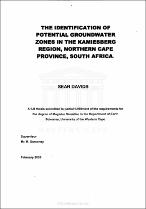| dc.description.abstract | The aim of the study is to apply remote sensing techniques to identify potential groundwater resources for the Kamiesberg region. This region, with vast water shortages relies solely on groundwater and is characterized by a fractured crystalline basement aquifer that lacks primary porosity. Groundwater in basement rock aquifers is likely to occur along open fractures and in weathered overburden zones. The study consisted of remote sensing analysis, aerial photography and Landsat images, and field investigations to ground truth the conceptual understanding. Field studies included geological mapping, lineament analyses and hydrogeological investigations. The Kamiesberg region is situated in the Namaqualand Metamorphic Complex (NMC), which is known for its mineral and alluvial diamond deposits. The NMC primarily consists of an assemblage of low- to high-grade metasedimentary rocks, unmetamorphosed platform sediments and an aray of granitic, basic and ultrabasic intrusive rocks. Three prominent deformations caused the general geological outline of the region, namely the Proterozoic deformations, Pan African orogenesis and Mesozoic breakup. The fracture and joint analyses confirmed a NNW mean trend. Secondary orientations are E-W, NW- SE and NE- SW. Fracture and joint analysis were contoured in lineament frequency/density and lineament intersection maps. The fractures and joints are zones of increased weathering and have a greater potential for groundwater storage. The maximum principle compressive stress (or) or neotectonics stress is orientated in a NW direction. The present groundwater state inferred from the national groundwater database (NGDB) suggests that boreholes are predominantly dry @7o/o), low yielding <1 lls @9%) and drilled in the weathered overburden at a depth of 40- 80m (90%). The results of the research identified potential groundwater zones for the Kamiesberg region. These zones were identified from a combination of Lineament frequency/density maps, lineament intersection maps, groundwater analyses and fieldwork. The zones are situated in and around the town of Kamieskroon and Lilienstein and south of Karkams. One of the potential sites identified, Kamieskroon, has current data on the groundwater state, and provides confidence to the conceptual understanding. The town has eight boreholes with yields ranging from 0.6- 1.6 l/s. Four of these boreholes are located in the weathered overburden (shallow boreholes), and the others are located along the NNW trending lineaments (deep boreholes). The zones identified from the study are potential groundwater resource sites, however, confirmation with geophysical surveys is essential. The data, however, has various shortcomings varying from lack of reliable data to the proximity of the potential resource to the community. It is critical to monitor existing and future groundwater resource sites (water levels, quality) and manage the resources in a sustainable way for optimal lifetime. | en_US |

